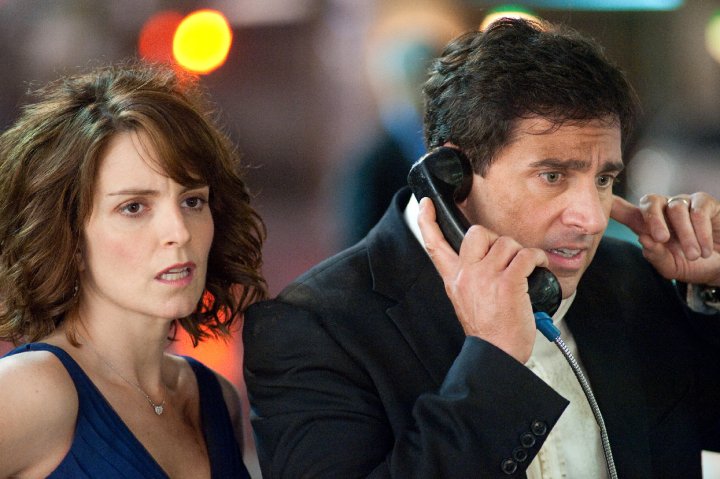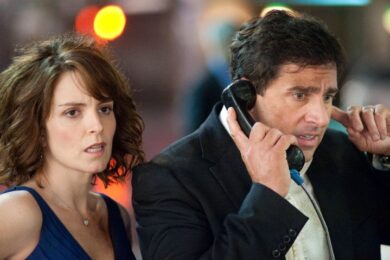If you are in your 20s and English, you may not really be familiar with the concept of a ‘date night’. Apparently it’s a staple of many American marriages: a designated evening in the week to get the babysitter in, book a table at your favourite local restaurant, cut loose with a bottle of the house red and profess that everything about your sedate suburban existence is aye-ok. A situation ripe with comedic potential? Add that to the amount of talent this movie has on board – Steve Carell; Tina Fey of 30 Rock fame; ‘Marky’ Mark Wallberg’s torso (which is exposed for the duration of all his scenes) and cameos from Ray Liotta, Mark Ruffalo, James Franco and Mila Kunis – and you would expect, if not a belly full of laughs, at least a good selection of humorous entrees. Unfortunately, we are barely even entitled to a burlesque breadstick.
The film starts in upstate New York, in the home of the Fosters, a typical married couple whose romantic routine is based around the titular marriage saving device. Tina Fey’s character Claire is an estate agent selling the suburban dream to her clients, enticing potential buyers with the prospect of a half hour commute to New York city (in fact she’s lying, it’s two hours). Steve Carell plays Phil, a generic desk in an insurance firm. Shades of American Beauty, perhaps. News of a friends’ divorce (the Sullivans; Mark Ruffalo and Kristen Wiig) forces them to question their own relationship: they resolve to leave the comfort of their suburban surroundings and spice things up with a spur of the moment dinner at a vogue seafood restaurant in the city, pretentiously called Claw. Unable to secure a table on the door, they steal another couple’s – the Tripplehorns – reservation. This small misdemeanor leads to a case of mistaken identity and a double pursuit plot which takes them on a picaresque tour of the Big Apple that, on the surface, sounds almost Hitchcockian. This, however, is a film made by people who have probably barely read the wikipedia entry on Hitchcock, let alone seen one of his films.
What is really going on with this pursuit plot is an escape from suburbia, and the feelings of ennui this can entail. It is intended as a device designed to inject a sense of excitement back into what seems to have become a comfortably routine marriage (there is one quite amusing scene in which Claire and Phil attempt to get things going in the conjugal department, ineffectually protesting they are both up for it, only to decide they are probably more in need of a Gaviscon than any kind of liaison). Here the results are perhaps predictable: the Fosters see each other in a different light, and Holbrooke’s (Mark Wallberg’s character) ubiquitous trunk is able to show Claire that she is not interested in superficial qualities, but Phil, the father of her children. However, it is only by leaving the amenity of the ’burbs that they are able to see the true value of their comfortable lives. It is as if the incongruous or the bizarre is the only way to expose the advantages the quaint repose of suburbia holds. The trip to the city is the film’s way of showing this, but escaping suburbia, whether geographically or metaphorically, seems to have been a trope Hollywood (and now much American television – see Desperate Housewives or Weeds) has always been interested in.
During the course of their meal at city restaurant Claw, they go to clink empty glasses. ‘Isn’t it bad luck?’ Claire asks. Phil doesn’t think it is. This could potentially be interpreted as a metaphor for their own existence: not half empty or half full, but completely hollow. On the other hand, this may be over-stating the point. It does work perfectly as a metaphor for the movie as a whole: a vapid, nugatory, paradoxically empty yet air filled receptacle. Anyway, irrespective of what was actually intended by this almost throw away sequence, the Fosters’ attempt at an urban renewal for their marriage doesn’t work particularly well. It is overwrought, under-scripted and forced. There was potential in this movie as the basic concept is solid, there is a lot of talent and at times it is funny (James Franco’s cameo, borrowing from his role in Pineapple Express, is actually hilarious). It perhaps needed a little more time in pre-production, and a little less reliance on Fey and Carell’s improvisatory talents.
What it did get me thinking about, however, was the number of other films that have dealt with the idea of suburban ennui, and had far more inventive ideas about how to handle it than a quick trip to the city. Perhaps the Fosters could have drawn inspiration from a few of these…
Blue Velvet
Suburbia is the setting for David Lynch’s seminal mystery thriller Blue Velvet, in which the director shows us the bizarre and dangerous world that can lurk just below the surface of an apparently idyllic suburb. The first scene moves in slow motion over white picket fences and bright flowers as Bobby Vinton croons ‘Blue Velvet’. Quickly, however, a man watering his lawn is struck down by a heart attack and the camera dives into the grass, showing in extreme and grotesque close up the insect community rummaging around under the canopy of the turf. ‘Blue Velvet’ gives way to Angelo Badalamenti’s Shostakovich inspired neo-noir score; Vinton’s romantic tenor has been replaced by arpeggiated bass lines and a swishing high hat. As soon as young Jeffrey Beaumont (Kyle MacLachlan) discovers a severed ear discarded in a field behind his house, you know that something more sinister than stag beetles lurks in the dark corners of this Robeson County suburb. Kidnapping, drug (ab/)use and sexual perversion are just some of the troubles he will encounter in unraveling the mystery of the discarded appendage.
The ‘Burbs
The ‘Burbs is an exercise in residential paranoia. It asks the question, what is going on over next-door’s fence? And, do we have the right to know? Suburbanite Ray Peterson (Tom Hanks) has misgivings about the Klopek’s, his new neighbors, hermit-like existence. But he is unsure if their reclusiveness is just a display of bashfulness, or whether it covers up more egregious operations. The decrepit house they live in and the abnormal sounds emanating from their basement seem to point towards to former. After discussing it with neighborhood pals Rumsfield and Art, Ray decides to investigate exactly what it is the bizarre bavarian family across the road are hiding behind their lace curtains, with shocking results.
Edward Scissorhands
Living in the purlieu tends not to be quite so boring if you have a twentieth century casualty of the Frankenstein myth living in the area. In Edward Scissorhands, Tim Burton’s fable of suburban isolation, the Boggs family’s home life bears an uncanny similarity to that of the Fosters. Situated in a cul-de-sac that looks as if Mr. Kipling may have designed the house fronts, Peg’s – the family matriarch and proud Avon saleswoman – discovery of Edward (Johnny Depp), the eponymous mechanically metacarpused hero, begins to reveal the inner politics of such a closed group. While at first Edward proves to be something of a sensation among the residents – using his dextrous talents to cut both hair and hedges – it soon becomes apparent that he will fall foul of their sniping and gossiping. This was an immensely personal project for Burton, who always felt like an outsider in his own suburban community, and Edward’s delicate, romantic sensibilities were never going to fit in with the cliques of the street. But things are certainly more exciting while he’s around.
Weird Science
John Hughes’ idiosyncratic fantasy-comedy Weird Science plays out every teenage male suburbanite’s fantasy. In another reworking of the Frankenstein legend, Wyatt (Ilan Mitchell-Smith) and Gary (Anthony Michael Hall), frustrated by their status with the girls at their high school, resolve to create their own perfect, older woman. There’s no better way to gain immediate status among your suburban peers than with Victoria’s Secret model on your arm and matching sports cars. And if you get to put a bra on your head in the process, all the better. (I do concede that the Fosters may be too old/married to partake in this particular suburban diversion, but many of us can indulge in the chimera.)
American Beauty
The shades of American Beauty were mentioned earlier, and if your marriage has become stagnant and uninspired, if it is actually beyond reconciliation, then you might as well have some fun as it implodes around you. Lester Burnham is trapped by his stationary, sterile marriage: from the first scene where we see him masturbating in the shower, the lines of the cubicle pen him in, confining his virility to these morning excursions. Lester’s journey in the film will be to break these constraints, to overthrow the shallow conventions of the superficial suburban world he sees around him, and finally come to terms with his age and his existence. This starts with a sexual reawakening, inspired by Angela, the aforementioned beguiling friend, and includes quitting the day job in favour of more menial employment – Mr. Smiley’s fast foot restaurant, to be precise -, a casual marijuana habit, excessive exercise and homoerotic flirtation along the way. Oh, and there’s something for the wife, too, as long as there’s an ivory veneered real estate king in the area.
The War Of The Roses
The pressure of a dull suburban marriage is too much for Barbara Rose (Kathleen Turner), and so she demands a divorce from her increasingly wealthy (and smug) husband Oliver (Michael Douglas) in The War of the Roses. The problem being, Oliver is secure in his suburban surroundings and refuses to leave the family home. This results in a sadistic game of one-upmanship designed to force the rival partner out. This film is more a parable of human relationships, but it is the stifling environment of their commuter belt that exacerbates the breakdown in the Roses relationship with such catastrophic results.
Donnie Darko
The character of Frank in Donnie Darko (the grotesque rabbit who appears to Donnie throughout) is one of the most confusing and disconcerting aspects of the film. It is difficult to decide whether he is a figment of Donnie’s imagination, or if he holds a more concrete, prescient purpose. The catalyst for his arrival is Donnie’s own struggle to exist in the eerie calm of the suburbs. A brilliant teenager grappling with mental illness, and in a similar way to Edward Scissorhands, Donnie is another example of delicate sensibilities being stifled by their environment; and the end of the film could even be read as his own desire to wipe suburbia from the landscape. Another lesson that this film teaches is that suburbia feels better with a reverberating, synth-driven post-punk soundtrack hanging over it: songs from INXS, The Church, Echo and the Bunnymen, Joy Division and Oingo Boingo capture the sense of brooding menace that lies beneath the sun-dappled beauty of this particular Californian suburb.
A Nightmare On Elm Street
Freddy Krueger has perhaps become one of the most iconic horror villains of all time. But it was arguably the small-town mentality of the metro-land that created this monster: it is the lynch-mob justice meted out by a group of angry parents that has apparently given Freddy his curious somnambulistic ability. Following on from John Carpenter’s seminal low-budget suburban horror Halloween, A Nightmare on Elm Street fully evokes the terror felt by a small, close-knit community under siege from a child killing psychopaths posthumous revenge.



